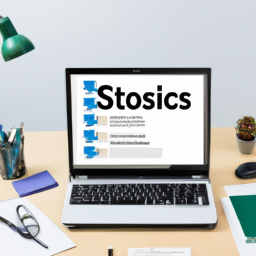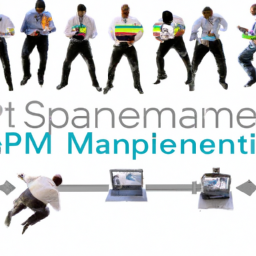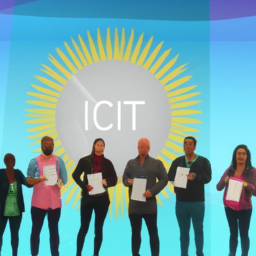Do you want to pass the PSM II exam with flying colors?
Well, here’s an interesting statistic for you: 85% of PSM II aspirants who master these 7 critical exam topics succeed on their first attempt.
So, if you’re ready to take your Scrum knowledge to the next level, you’ve come to the right place.
In this article, we’ll dive into the essential topics you need to master, including Agile principles, Scrum framework, and more.
Get ready to ace that exam!
Key Takeaways
- Embrace change, collaboration, and adaptability
- Deliver value to the customer and welcome feedback
- Understand the roles and responsibilities of the Scrum Team, Scrum Master, Product Owner, Stakeholders, and Development Team
- Prioritize user stories based on value and project goals and regularly refine the product backlog to ensure relevance and alignment.
Agile Principles and Values
You should understand that Agile principles and values are essential for success in the PSM II exam. Having an agile mindset is crucial in the world of Scrum. It means embracing change, collaboration, and adaptability.
Agile principles emphasize delivering value to the customer, welcoming customer feedback, and promoting self-organizing teams. By understanding and applying these principles, you can effectively navigate the complex challenges that may arise during the exam.
Continuous improvement is another key aspect of Agile. It involves regularly reflecting on your performance and seeking ways to enhance it. In the PSM II exam, this means constantly evaluating your knowledge, skills, and understanding of Scrum, and striving to improve them. It requires being open to feedback, actively seeking opportunities for growth, and being willing to adapt your approach based on new insights.
Scrum Framework and Roles
In this discussion, you will explore the key points of the Scrum Framework and Roles.
You will learn about the different Scrum roles, such as the Product Owner, Scrum Master, and Development Team, and their responsibilities in the Scrum process.
Additionally, you will delve into the essential components of the Scrum Framework, including the Scrum events, artifacts, and rules that guide the development process.
Understanding these key aspects of Scrum will enable you to effectively implement and leverage Scrum in your own projects.
Key Scrum Roles
When aspiring for the PSM II exam, it’s crucial to understand the key roles in Scrum. Here are the important roles you need to be familiar with:
-
Scrum Team: The team responsible for delivering the product increment. They work together to achieve the sprint goal and collaborate on all aspects of the project.
-
Scrum Master: This role is responsible for ensuring the Scrum framework is followed, facilitating meetings, removing impediments, and supporting the team. They are the servant-leader of the Scrum Team.
-
Product Owner: The person responsible for maximizing the value of the product by managing the product backlog, prioritizing user stories, and ensuring the team works on the most valuable items.
-
Stakeholders: Individuals or groups with an interest in the project. They provide input, feedback, and support to the Scrum Team.
-
Development Team: The professionals who actually do the work to create the product increment. They self-organize and collaborate to deliver high-quality work.
Understanding these key roles and their dynamics is essential for success in the PSM II exam and in real-world Scrum implementations.
Scrum Framework Components
To fully understand the Scrum framework, it’s important to grasp the components that make it up.
One key component is the sprint review feedback. This is a crucial part of the Scrum process as it allows the Scrum team to gather feedback from stakeholders and users on the product increment created during the sprint. This feedback helps the team determine if they are on the right track and if any adjustments need to be made.
Another important component is scrum team collaboration. Effective collaboration is essential for the success of the Scrum team. It involves open communication, sharing of ideas, and working together towards a common goal. Through collaboration, the team can leverage the collective knowledge and skills of its members to deliver high-quality products.
Now, let’s move on to the next section about product backlog refinement.
Product Backlog Refinement
The importance of product backlog refinement cannot be overstated in the PSM II exam. It is a critical aspect of the Scrum framework that every aspiring PSM II must master. Here are some key points to help you understand the significance of product backlog refinement:
-
Product backlog prioritization: Learn how to prioritize user stories based on their value to the customer and the project goals.
-
User story mapping: Gain an understanding of how to visualize the user journey and map out the flow of user stories to ensure a cohesive product.
-
Continuous improvement: Emphasize the need for regular backlog refinement sessions to ensure the product backlog remains relevant and aligned with the project’s objectives.
-
Collaboration: Foster effective communication and collaboration among the development team, product owner, and stakeholders during the refinement process.
-
Adaptability: Be prepared to adapt and refine the product backlog as new information or requirements emerge.
Mastering product backlog refinement will not only help you excel in the PSM II exam but also in your role as a Scrum professional.
Sprint Planning and Execution
You should focus on sprint planning and execution to ensure a successful Scrum project.
Sprint planning sets the stage for a productive sprint by defining the sprint goal and selecting the backlog items to be worked on. During this process, it’s essential to involve the entire Scrum team to ensure everyone is aligned and understands the objectives.
Once the planning is complete, it’s time for execution. This involves the actual development work and daily scrum meetings to keep everyone updated on progress and address any impediments. Throughout the sprint, it is crucial to track the sprint goal and ensure that the team is working towards it.
At the end of the sprint, sprint retrospectives provide an opportunity to reflect on the team’s performance and identify areas for improvement, enabling continuous improvement in future sprints.
Release Planning and Forecasting
During release planning, the team collaborates to determine the scope and timeline for delivering the product increments. This crucial step in the agile development process allows for effective capacity planning and risk management.
To ensure successful release planning and forecasting, consider the following:
- Clearly define the product vision and goals.
- Break down the work into manageable user stories or features.
- Estimate the effort required for each item.
- Prioritize the backlog based on value and dependencies.
- Continuously monitor and adapt the release plan as new information becomes available.
By incorporating capacity planning and risk management into the release planning process, the team can effectively allocate resources, identify potential challenges, and make informed decisions.
This sets the stage for successful agile estimation and planning, which we will explore in the next section.
Agile Estimation and Planning
Now that you have an understanding of release planning and forecasting, let’s dive into the topic of agile estimation and planning.
In agile, accurate forecasting is crucial for successful project management. One popular technique used for estimation is story points. Story points are a relative measure of effort required to complete a user story or a task. By assigning story points to each item in the product backlog, the team can estimate the effort needed and plan accordingly.
Agile forecasting involves using historical data and team velocity to predict the completion of future work. It allows for adaptability and flexibility in adjusting plans based on changing priorities and team capacity.
Agile estimation and planning are essential skills for a PSM II aspirant to master in order to effectively manage projects in an agile environment.
Moving forward, let’s explore the next subtopic: scrum metrics and reporting.
Scrum Metrics and Reporting
Take a moment to explore the importance of scrum metrics and reporting in agile project management.
Scrum metrics analysis and reporting are essential for tracking the progress of your agile projects. By measuring and analyzing various metrics, you can gain valuable insights into the team’s performance and identify areas for improvement.
Here are some reporting best practices to consider:
- Use burn-down charts to visualize the progress of your sprints.
- Track velocity to understand the team’s capacity and predict future delivery.
- Monitor cycle time to identify bottlenecks and optimize workflow.
- Measure customer satisfaction to ensure that your deliverables meet their expectations.
- Analyze defect density to identify patterns and improve product quality.
Frequently Asked Questions
What Are the Key Differences Between the PSM II and PSM I Certifications?
When comparing the PSM II and PSM I certifications, it’s important to understand the key differences.
The PSM II certification is designed for advanced Scrum Masters, while the PSM I certification is for those starting their Scrum journey.
PSM II requires a deeper understanding of Scrum principles, frameworks, and practices, as well as the ability to apply them in complex situations.
PSM I focuses more on the basics of Scrum and ensuring a solid foundation.
How Can a Scrum Master Effectively Handle Conflicts Within a Scrum Team?
To effectively handle conflicts within a scrum team, you need to be equipped with conflict resolution techniques and team collaboration strategies.
It’s important to address conflicts head-on and encourage open communication among team members.
Foster a collaborative environment where everyone feels comfortable expressing their opinions and concerns.
Act as a mediator and help facilitate discussions to find common ground and reach a resolution.
What Are Some Common Challenges Faced During the Implementation of Scrum in an Organization?
Implementing Scrum in an organization can be filled with challenges. From resistance to change to lack of understanding, you may face various obstacles along the way.
It’s crucial to address these challenges head-on and find solutions that work for your team. By fostering open communication, providing proper training, and continuously adapting, you can overcome the hurdles of implementing Scrum and create a successful agile environment.
Stay focused, stay determined, and remember that every challenge is an opportunity for growth.
How Can a Scrum Master Foster a Culture of Continuous Improvement Within a Scrum Team?
To foster a culture of continuous improvement within your Scrum team, focus on implementing various continuous improvement techniques. Encourage regular retrospectives where the team reflects on their processes, identifies areas for improvement, and takes action.
Actively listen to team members’ suggestions and encourage open communication. Facilitate knowledge sharing and learning opportunities to enhance Scrum team productivity.
What Strategies Can Be Used to Handle Stakeholders Who Are Resistant to Adopting Scrum Practices?
When dealing with resistant stakeholders, it’s important to have a clear strategy in place.
You can start by identifying the root causes of their resistance and addressing them directly.
Communicate the benefits and value of adopting Scrum practices, showing how it aligns with their goals and objectives.
Listen to their concerns and address them openly and honestly.
Build trust and credibility by demonstrating successful Scrum implementations and showcasing positive outcomes.
Conclusion
So there you have it, aspiring PSM II candidates! After mastering these seven critical exam topics, you’ll be well on your way to becoming a certified Scrum Master extraordinaire.
Agile principles and values, the Scrum framework and roles, product backlog refinement, sprint planning and execution, release planning and forecasting, agile estimation and planning, and scrum metrics and reporting. These are the building blocks of success in the world of Scrum.
So go forth, my friends, and conquer that exam like a true agile champion! Good luck!


















